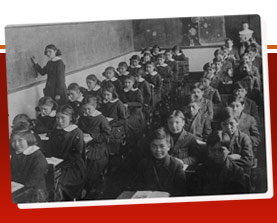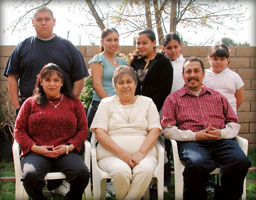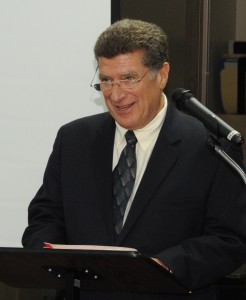News & Announcements
- Details
- Written by Joshua Wachtel
 Aboriginal Children in a Canadian Residential SchoolFrom the 1870s to the 1990s, more than 150,000 First Nations, Métis and Inuit children were taken from their families and placed in government-funded, church-run Residential Schools. Aboriginal children were punished for speaking their own language or following traditional cultural practices and suffered emotional, physical and/or sexual abuse; some died. Their unresolved trauma, passed from generation to generation, has had a profoundly negative effect on the relationship between Aboriginal peoples and other Canadians.
Aboriginal Children in a Canadian Residential SchoolFrom the 1870s to the 1990s, more than 150,000 First Nations, Métis and Inuit children were taken from their families and placed in government-funded, church-run Residential Schools. Aboriginal children were punished for speaking their own language or following traditional cultural practices and suffered emotional, physical and/or sexual abuse; some died. Their unresolved trauma, passed from generation to generation, has had a profoundly negative effect on the relationship between Aboriginal peoples and other Canadians.
As explained at the The Truth and Reconciliation Commission of Canada web site (trc.ca) the TRC "has a mandate to learn the truth about what happened in the residential schools and to inform all Canadians about what happened in the schools. The Commission will document the truth of what happened by relying on records held by those who operated and funded the schools, testimony from officials of the institutions that operated the schools, and experiences reported by survivors, their families, communities and anyone personally affected by the residential school experience and its subsequent impacts."
For the Children Taken, for the Parent Left Behind
- Details
- Written by Frida Rundell
The second book in The Peacebuilding Compared Project, led by restorative justice pioneer John Braithwaite, addresses peacebuilding efforts in the long-beleaguered South Pacific island of Bougainville and answers questions about what works best to build peace. The book is reviewed and summarized by IIRP founding faculty member Frida Rundell.
- Details
- Written by Joshua Wachtel
 SaferSanerSchools instructor Lee Rush has been invited along with 80 other national leaders to attend a Symposium on Youth Meanness and Cruelty at Harvard University in Cambridge, Massachusetts on Wednesday, February 29. This event coincides with the launch of Lady Gaga's Born This Way Foundation. The Symposium is hosted by the
SaferSanerSchools instructor Lee Rush has been invited along with 80 other national leaders to attend a Symposium on Youth Meanness and Cruelty at Harvard University in Cambridge, Massachusetts on Wednesday, February 29. This event coincides with the launch of Lady Gaga's Born This Way Foundation. The Symposium is hosted by the  Berkman Center for Internet & Society in partnership with the Harvard Graduate School of Education and is supported by the MacArthur Foundation.
Berkman Center for Internet & Society in partnership with the Harvard Graduate School of Education and is supported by the MacArthur Foundation.
The Symposium is a working meeting that will focus on a variety of issues related to youth bullying, both on and offline. Rush will be working with the School Culture and Climate work-stream. This is one of six 15-member groups of experts, researchers, policymakers, foundation representatives, and others who will meet twice during the day and report back to the entire group.
- Details
- Written by Joshua Wachtel
 "A Family Satisfied with FGDM, from the Famly Voices Video, a co-production of IIRP & American Humane"American Humane has announced its 2012 Conference on Family Group Decision Making and Other Family Engagement Approaches: June 20-24, 2012 at the Disney Yacht & Beach Club Resort, Orlando, FL
"A Family Satisfied with FGDM, from the Famly Voices Video, a co-production of IIRP & American Humane"American Humane has announced its 2012 Conference on Family Group Decision Making and Other Family Engagement Approaches: June 20-24, 2012 at the Disney Yacht & Beach Club Resort, Orlando, FL
Join over 500 conference participants to enjoy a variety of ways to explore community partnership building, the intersection between practice and values, organizational and systems change, research and evaluation, and learning across systems — all in relation to FGDM and other family engagement approaches in child welfare, mental health, education and juvenile justice systems. This conference allows child welfare professionals from many different fields to come together for networking, training and information sharing. It is organized to meet the needs of anyone at any level within many systems who want to begin, improve or sustain engaging families in decision making.
- Details
- Written by Frida Rundell
Have you read this book? Leave a comment below.
Introduction
Reconciliation and Architectures of Commitment: Sequencing Peace in Bougainville, published September 2010, is a publication of the Peacebuilding Compared Project (http://peacebuilding.anu.edu.au) of the Centre for International Governance & Justice (CICJ) of the Australian National University (ANU), Canberra. The book is the second of three published so far. The first, Anomie and Violence: Non-truth and Reconciliation in Indonesian Peacebuilding, was published in March 2010; the third, Pillars and Shadows: Statebuilding as Peacebuilding in Solomon Islands, was published in November 2010. Links to free downloads of all three books are available at: http://epress.anu.edu.au?p=57571.
- Details
- Written by Joshua Wachtel
 Coos Bay Bridge. Photo by Too Far North (Karyn Christner) via Flickr Creative CommonsHere's a story about a restorative justice program embedded in the court system on a tribal reservation in Oregon.
Coos Bay Bridge. Photo by Too Far North (Karyn Christner) via Flickr Creative CommonsHere's a story about a restorative justice program embedded in the court system on a tribal reservation in Oregon.
[The] system is known as the Peacegiving Court. [Judge Donald] Costello was part of a team that invented it in Deschutes County, and now it's part of the judicial systems for both the Coquille Indian Tribe and the Confederated Tribes of Coos, Lower Umpqua and Suislaw Indians.
- Details
- Written by Joshua Wachtel
 Monday, the SF Examiner posted this piece "There’s more than one way to stop bullying in school" by Carlos A. Garcia, superintendent of the San Francisco Unified School District. Some excerpts of the short piece include:
Monday, the SF Examiner posted this piece "There’s more than one way to stop bullying in school" by Carlos A. Garcia, superintendent of the San Francisco Unified School District. Some excerpts of the short piece include:
When students feel connected and safe at school, they learn better. Last year, 75 percent of students surveyed in high schools and 62 percent in middle schools reported “always feeling safe at school.” I would like to see this percentage grow to 100.
- Details
- Written by Joshua Wachtel
 Representatives from the Flanker Peace and Justice Centre in Montego BayHere are links to two more articles from Jamaica regarding Restorative Justice Week (Feb. 5 - 11, 2012).
Representatives from the Flanker Peace and Justice Centre in Montego BayHere are links to two more articles from Jamaica regarding Restorative Justice Week (Feb. 5 - 11, 2012).
The first – Gov't Committed to Achieving Safe and Harmonious Society – includes photos from the opening of Granville Restorative Justice Centre, one of four new neighborhood centers that opened last week.
The second – Justice Ministry Provides Information at Fairs – discusses fairs organized in two of the other communities to provide information to the public about restorative justice.
- Details
- Written by Joshua Wachtel
 Here's a piece by IIRP president Ted Wachtel that appeared on University Business Magazine's web site:
Here's a piece by IIRP president Ted Wachtel that appeared on University Business Magazine's web site:
Campus residence hall advisors (RAs) have a tough job. But there is a tool that can make their work easier and more effective: restorative practices.
Most RAs sign on for the job because they want to help build community, provide guidance to their peers and learn what it means to be in a leadership role. RAs, however, also are charged with managing behavior. They are granted a certain amount of authority to enforce campus policies, rules and regulations.
- Details
- Written by Joshua Wachtel
 In this piece, "Less Prison, better prevention of crime," Australian criminologist John Braithwaite argues that the evidence shows in so many areas that restorative rather than punitive responses, and also evidence-based responses to preventing crime, provide a better return on government investment by reducing crime and serving the needs of victims.
In this piece, "Less Prison, better prevention of crime," Australian criminologist John Braithwaite argues that the evidence shows in so many areas that restorative rather than punitive responses, and also evidence-based responses to preventing crime, provide a better return on government investment by reducing crime and serving the needs of victims.
Braithwaite discusses prisons, policing, restorative justice, remorse, forgiveness, anti-bullying programs, fraudulent shifting of corporate profits to off shore tax havens and the US housing crisis in this terse and powerful article. Read it here.
John Braithwaite is an Australian Research Council Federation Fellow and Founder of RegNet (the Regulatory Institutions Network) at the Australian National University. He is embarking on a 20-year comparative project called 'Peacebuilding Compared', with Hilary Charlesworth, Valerie Braithwaite and Kate Macfarlane. He is also an honorary trustee of IIRP.

Restorative Works Year in Review 2023 (PDF)
All our donors are acknowledged annually in Restorative Works.
